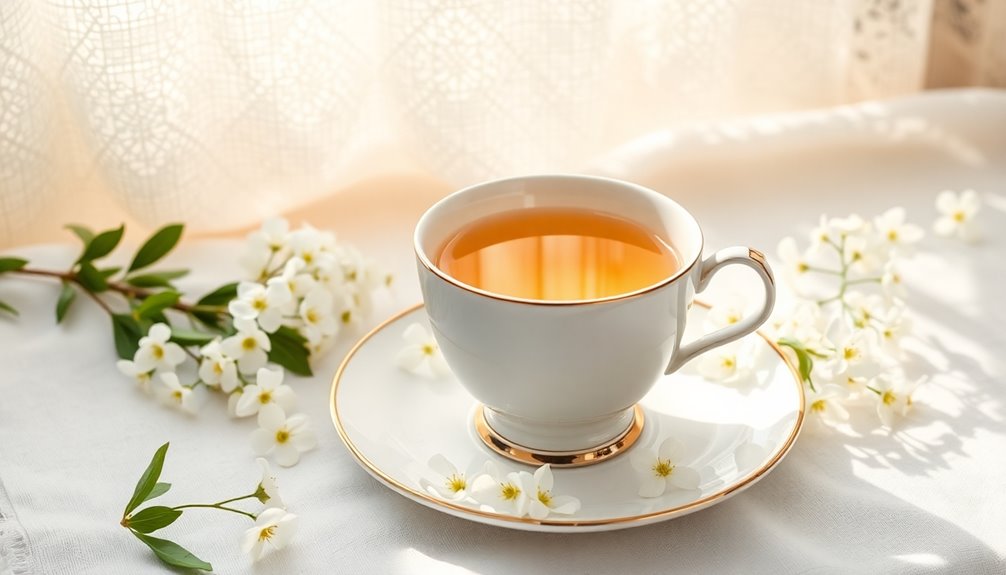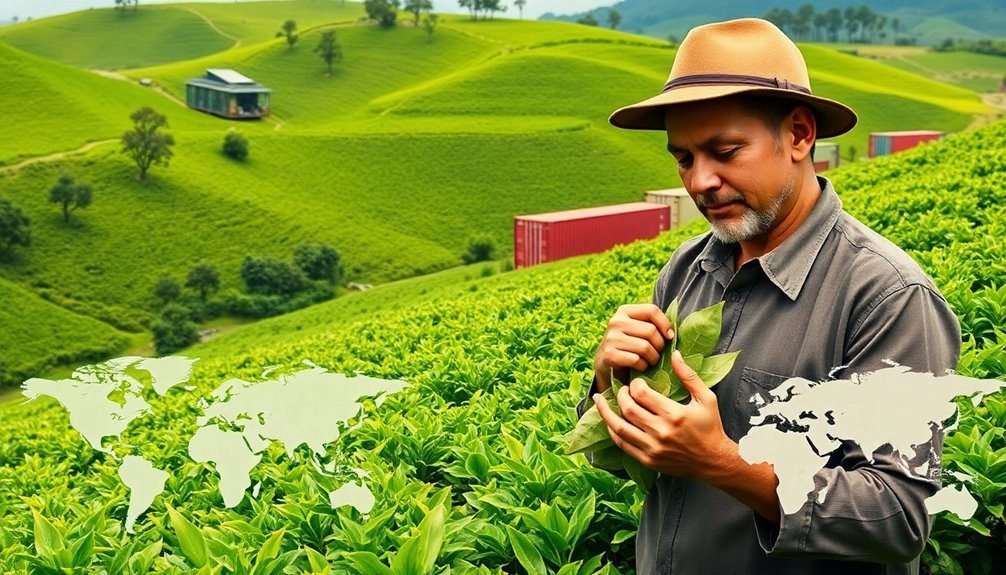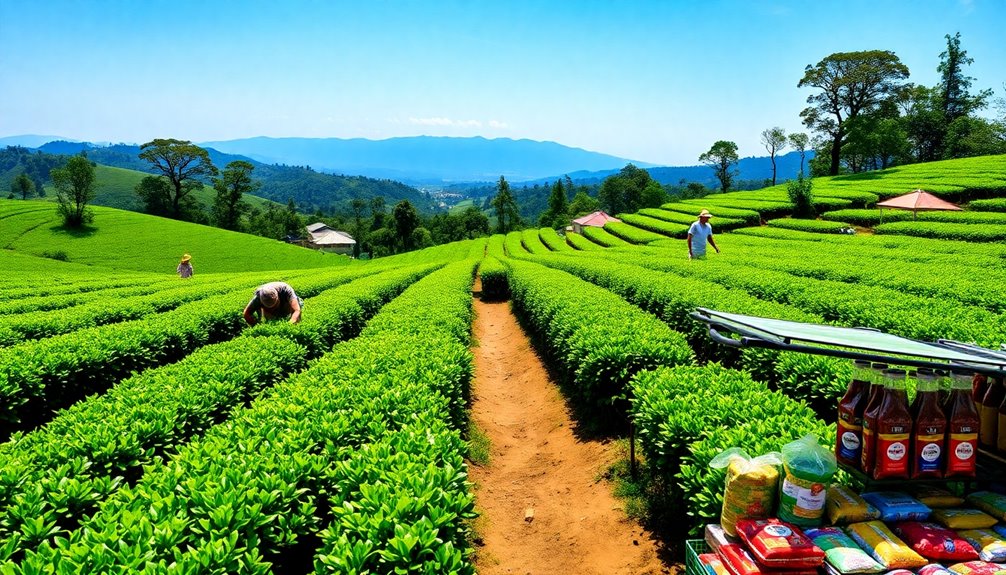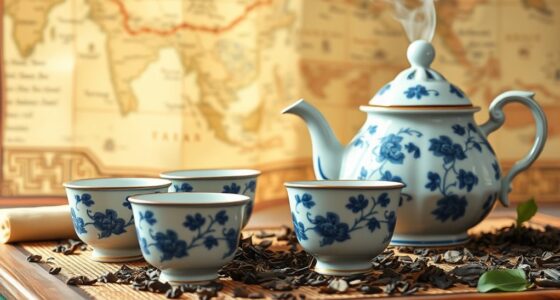Tea transformed into a billion-dollar industry thanks to its rich history and worldwide appeal. It started in ancient China, traveling along trade routes like the Silk Road. Over time, famous traders brought it to Europe, making it popular. Now, tea is the second most consumed drink after water! Smallholder farmers grow a lot of this delicious beverage, and celebrity endorsements make brands even more exciting. Today, the tea market is worth over USD 17 billion, supporting communities and embracing sustainability. If you're curious about how tea continues to flourish, there's so much more to discover!
Key Takeaways
- Tea's global market value exceeds USD 17 billion, driven by its status as the second most consumed beverage after water.
- Smallholder farmers, who produce 60% of global tea, play a crucial role in the industry's sustainability and growth.
- Historical trade routes, starting from ancient China, established tea as a valuable commodity in global commerce.
- Celebrity endorsements have significantly increased brand visibility and sales, contributing to the industry's expansion.
- Ethical sourcing and sustainability initiatives are essential for maintaining fair prices and supporting farming communities in the tea sector.
Introduction

Tea has long been cherished not just for its flavor but as a vital part of cultures worldwide. You mightn't know it, but over 13 million people work in the global tea production sector! Among them, smallholder tea farmers play a huge role, contributing 60% of the world's tea.
This billion-dollar industry, valued at over USD 17 billion annually, is the second most consumed beverage after water. It's hard to believe that something so delicious can also be an important economic driver, especially for many low-income economies.
But it's not all smooth sailing for tea farmers. They often face tough challenges, like production costs that sometimes exceed what they earn. That's why fair pricing is so important. It helps ensure they can keep growing this beloved plant.
The industry is also making strides towards sustainability. Around 25% of global tea is produced under Voluntary Sustainability Standards (VSS). This shift shows that tea farmers aren't just thinking about profits; they're also caring for the planet.
Tea's Historical Trade Routes

When you think about the journey of tea, it's fascinating to realize how its trade routes have shaped cultures and economies for centuries.
Tea production began in ancient China, where it was first cultivated and traded along the Silk Road as early as the 7th century. This special drink became a valuable commodity, connecting East and West.
By the 16th century, Portuguese and Dutch traders started importing tea to Europe, making it increasingly popular. They established maritime trade routes that linked Asia to European markets, changing how people enjoyed this refreshing beverage.
The British East India Company took it further in the 17th and 18th centuries, controlling tea imports into England and turning tea into a beloved staple.
However, the 19th century brought challenges. The opium trade altered tea trade routes, as British merchants exchanged opium for tea in China, leading to the Opium Wars.
Today, global tea trade thrives, with major exporting countries like China, India, and Sri Lanka keeping those historical connections alive while adapting to modern logistics.
Isn't it amazing how tea's journey has shaped the world we live in?
Global Tea Consumption Trends
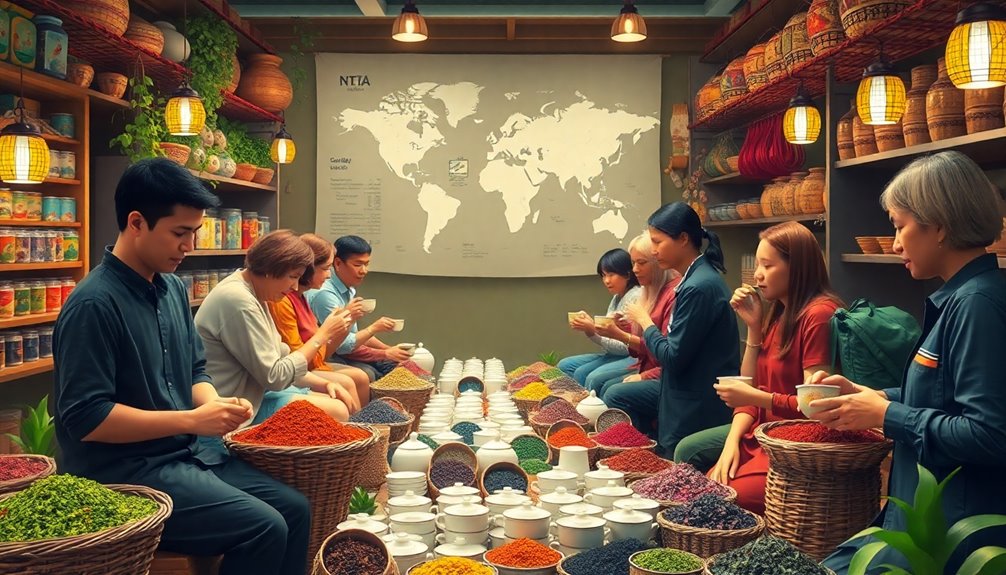
Around the world, millions of people reach for a cup of tea daily, making it the most consumed beverage after water. Tea is more than just a drink; it's a big part of life for many. Did you know that over 13 million people work in the tea industry? Most of them are smallholder farmers, and they produce about 60% of the world's tea!
In 2022, the global tea production was worth over USD 17 billion. That's a huge number! While many enjoy tea, smallholder farmers often struggle. They face tough times because their production costs can be higher than their earnings. This is why it's so important that these farmers receive fair prices for their hard work. When they do, it helps their families and communities thrive.
Tea isn't just a drink; it connects people and supports economies. The tea trade, valued at USD 9.5 billion, helps many low-income countries.
Celebrity-Endorsed Tea Brands

As the popularity of tea continues to rise, many brands are capitalizing on celebrity endorsements to boost their visibility and appeal. You might've noticed how famous faces can make a brand really stand out. For example, Arnold Palmer teamed up with Arizona Iced Tea in 2002 to create a delicious mix of half tea and half lemonade. This clever partnership not only caught your eye but also made the drink feel special.
Celebrity-endorsed tea brands often offer exciting new flavors that you mightn't find anywhere else. By tapping into the influence of public figures, these brands reach different groups of people, making tea more appealing to everyone. When your favorite celebrity promotes a tea, you're more likely to give it a try, right? That's the power of celebrity endorsements! Many of these brands also highlight the health benefits of tea, such as its rich antioxidants, to further entice consumers.
These partnerships can really drive sales, encouraging you and others to become loyal fans. Plus, many brands focus on unique packaging and pricing to attract budget-conscious shoppers like you. Additionally, the tea market, valued at approximately $200 billion(https://example.com) in 2022, shows the immense financial potential of this booming industry.
With such fun and creative options, it's no wonder celebrity-endorsed tea brands are becoming a key part of the booming tea industry!
Ethical Sourcing of Tea

While celebrity endorsements have boosted tea's popularity, the industry's growth also raises important questions about ethical sourcing. You mightn't know that smallholder farmers produced 60% of global tea in 2022!
It's crucial that these farmers receive fair prices for their tea leaves and support for sustainable practices. They often face tough economic challenges, so ethical sourcing of tea becomes vital.
Voluntary Sustainability Standards (VSS) help guide this process. In fact, at least 25% of global tea production meets VSS requirements.
However, it's concerning that 90% of the time, VSS-compliant tea gets mislabelled as conventional. This lack of transparency makes it hard for you to know if your tea is ethically sourced.
Practical Applications

Practical applications of ethical sourcing in the tea industry can significantly enhance the livelihoods of smallholder farmers. By focusing on sustainable practices, farmers can improve soil fertility, leading to better tea quality and higher yields. Additionally, implementing gold IRAs can provide farmers with a secure investment option that helps them protect their income against economic fluctuations. This aligns with the principles of the Law of Attraction, which emphasize the importance of positive outcomes through proactive efforts. Furthermore, embracing practices that promote digestive health can lead to improved overall well-being for farmers and their families.
When you support these practices, you help create a healthier environment for future generations.
One exciting way to make a difference is by adopting Voluntary Sustainability Standards (VSS). These standards encourage farmers to use eco-friendly methods, which not only protect the land but also boost their income. With over 25% of global tea production following these guidelines, it's clear that change is happening!
Fair pricing structures are another vital part of this equation. When farmers receive fair prices for their tea, they can invest in their farms and families. This means better living conditions, education for children, and improved health care. Plus, greater market transparency helps everyone in the tea trade, ensuring that the benefits flow back to the communities that grow the tea you love. Additionally, similar to the tea industry, yerba mate's emphasis on cultural significance highlights the importance of community and tradition in promoting sustainable agricultural practices.
Frequently Asked Questions
Is Tea a Billion Dollar Industry?
Yes, tea's indeed a billion-dollar industry. With global production valued over USD 17 billion, it plays a crucial role in the beverage market, benefiting economies and smallholder farmers, while highlighting sustainability challenges and fair pricing needs.
Why Did Tea Become so Popular?
Tea became popular due to its versatility, unique flavors, and cultural significance. You've likely enjoyed its calming effects, social aspects, and health benefits, which all contribute to its widespread appeal across different demographics and regions.
How Did Tea Become a Global Commodity?
Tea became a global commodity through extensive trade networks, colonial expansion, and increasing consumer demand. You'll find it essential to recognize how cultural significance and accessibility contributed to its widespread popularity and economic importance worldwide.
Who Was Profiting From Tea?
You'll find that large corporations and traders profit the most from tea. Meanwhile, smallholder farmers struggle with low prices and production costs, highlighting the need for fair pricing to ensure equitable earnings across the industry.
Conclusion
Tea's journey from ancient leaves to a billion-dollar industry is truly amazing! You've learned about its rich history, how people all over the world love it, and even how celebrities help make it popular. Plus, knowing that tea can be sourced ethically makes it even better! So, whether you enjoy a warm cup with friends or try a trendy brand, remember that every sip connects you to a global story. Cheers to tea and all its wonders!


